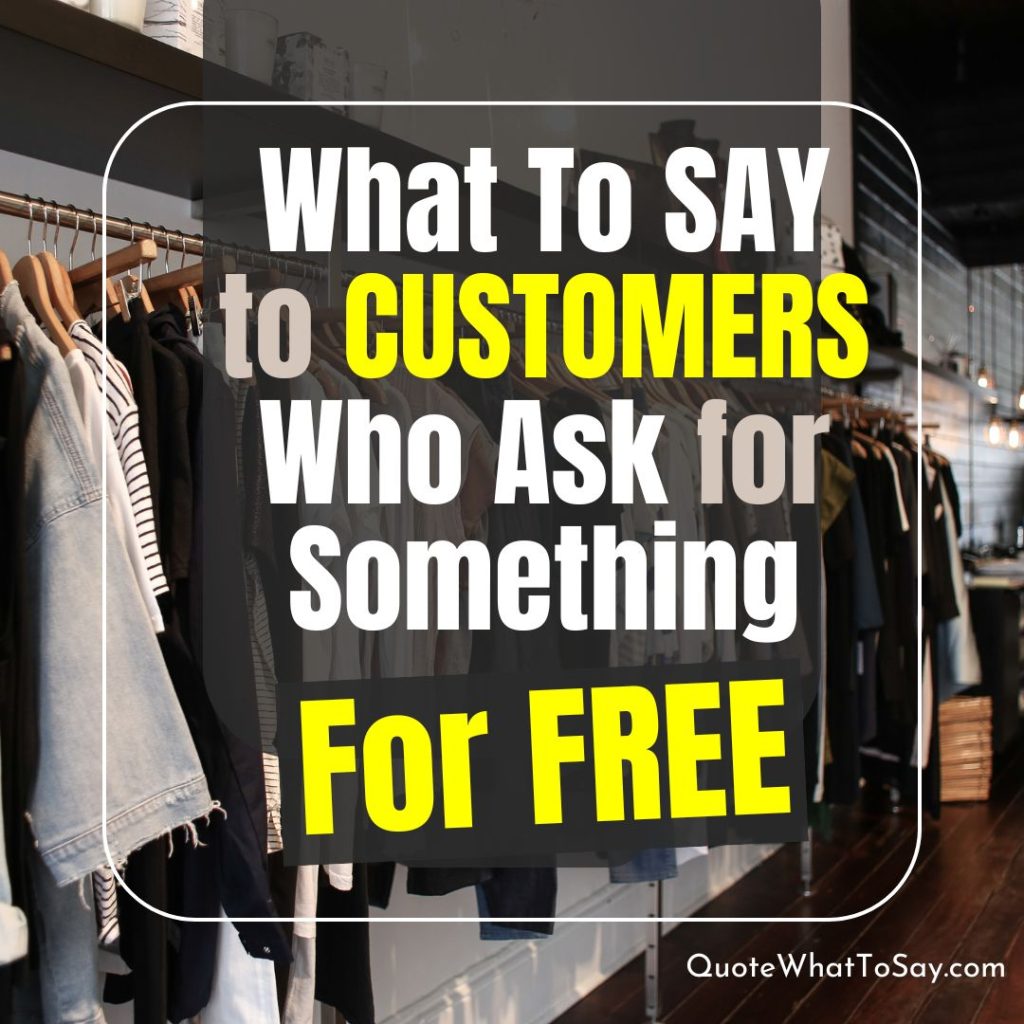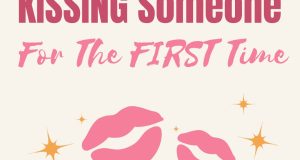In the world of business, it is common to encounter customers who ask for something at no charge.
These requests can range from samples, add-on, or full products and services for free.
It is essential for businesses to navigate these requests gracefully while maintaining value, showing appreciation, and building long-term customer relationships.
This guide covers some effective ways to handle these situations –
including 68 examples of what to say and 5 sample email templates, focus on keeping your customer satisfied without devaluing your offerings.

Dealing with Customers Who Ask for Something for Free
It is never easy to handle challenging customers with “unreasonable demand” or “ridiculous request”.
For examples, what to say when someone asks you to work for free, how to deal with customers who ask for something for free, and how to say “No” to a customer?
1. Understand the Request
When a customer asks for something for free, try to understand the motivation behind the request before responding.
Not all requests for free items are based on entitlement. Sometimes, customers genuinely believe they are entitled to an additional benefit, while others may be testing the waters to see if there is flexibility.
Common reasons customers ask for free items include:
– Testing product quality: They want assurance that your product or service is worth the price.
– Budget constraints: They might have limited resources but still want to benefit from your offerings.
– Promotion or partnership: Some customers may feel that their platform or network would benefit your business.
– Loyalty: They might feel their continued support justifies a reward.
By understanding the reason behind the request, you can tailor your response to suit the situation and offer an appropriate solution.
2. Show Empathy and Appreciation
Regardless of whether you can fulfill the request, it is essential to show appreciation for their interest in your business.
Acknowledging their request respectfully goes a long way in maintaining a positive relationship.
Use language that expresses gratitude, such as:
- “I appreciate your interest, but we are unable to move forward with that.”
- “Thank you for your interest! We love that you are excited to try [product/service].”
- “We are so glad you enjoy our products and would like to experience more of them.”
- “We appreciate your interest! Unfortunately, we’re unable to offer this for free.”
- “We are so glad you’re interested in us, and we’d love to answer any questions you have.”
- “Thank you for your enthusiasm! While we can’t provide it free, we’d love to help you get started.”
- “We are grateful for your enthusiasm about [product/service], and we’d love to welcome you as a customer.”
- “We appreciate your loyalty and enthusiasm for our brand. I see what you are asking for, but I’m unable to fulfill that request. ”
By showing empathy and gratitude, you make the customer feel valued. This also helps soften the impact if you have to deny their request.
3. Emphasize the Value of Your Product or Service
Sometimes, customers may not fully understand the value or effort behind your product or service, leading them to believe that giving it away is feasible.
Use this as an opportunity to highlight what makes your product or service worth its price.
Be transparent about the quality, benefits, or unique elements of what you offer.
For examples:
- “I hear you. Yet, we can’t proceed that way. We are proud of the level of quality we offer, and we price our [products/services] to reflect that.”
- “Each of our [products/services] is backed by our quality guarantee, which reflects its value.”
- “Our team is dedicated to providing the best, and our pricing reflects the quality we’re committed to.”
- “Our products are made with the highest quality [ingredients/materials], ensuring long-lasting results.”
- “I regret to say that’s not a possibility. We stand by the quality of our [product/service], which is why it comes with a cost to match its value.”
- “We’ve put significant resources into making [product/service] exceptional, and it’s priced accordingly.”
- “We believe that our [product/service] offers true value and provides an experience worth the investment.”
- “I’m sorry, that is not something we can accommodate. To maintain the quality you’d expect, we don’t typically offer this for free.”
- “Our team invests a lot of time and expertise into each service to ensure you get the best experience possible, so we’re unable to offer this for free.”
- “I understand your request, but that is not something we can do. To support the value we provide to every customer, we’re unable to give [product/service] away for free.”
Positioning your offering as a valuable and premium product helps customers see why it may not be something that can simply be given away for free.
4. Offer a Small Incentive
If budget allows, consider offering a small incentive rather than something completely free.
A small discount, a sample-sized product, or a limited-time offer can help satisfy the customer without devaluing your full offerings.
For examples:
- “That is not something we can do, but we can offer you a discount code for your first purchase if you’d like to give it a try.”
- “We’d love to extend a limited-time discount as a way for you to try us out.”
- “We can’t offer this for free, but we’d love to give you a discount on your first purchase.”
- “We don’t provide free [products/services], but we’re happy to offer a one-time discount!”
- “If you are interested, we have a special promotion this month with a [X%] discounted rate.”
- “I’m afraid that won’t be possible. While we can’t offer it for free, we do have a [X%] discount code you can use!”
- “We don’t typically offer our products for free, but we’d be happy to offer a sample size for you to experience the quality.”
- “While we can’t give away a full product, we have a special promotion coming up that we’d love to include you in!”
By offering an incentive, you show goodwill without giving away your product or service outright. This approach helps build trust and gives customers a reason to make a purchase.
5. Redirect to Free Resources
If you have free resources that could be of interest, a great alternative is to direct the customer to such resources like blogs, guides, videos, or demos.
This approach adds value without costing your business, while positions your brand as generous and resourceful.
You might say:
- “Let’s explore other options that may work for you. While we don’t provide [product/service] for free, we have a variety of free resources on our website that you may find helpful.”
- “Our [eBook/blog/videos] can provide valuable insights at no cost.”
- “You can explore our free [resource center/blog] for tips and insights.”
- “I’m sorry, I can’t commit to that. Feel free to access our resource library, where you’ll find free tools and guides.”
- “We have a variety of free content available that may help answer your questions.”
- “Our free trial might be a great place to start if you’d like to experience what we offer.”
- “You can sign up for our free trial to get a sense of our [product/service] before committing.”
- “Our [blog / YouTube channel] is filled with tips and insights you can benefit from at no cost!”
- “While our [product/service] is not free, you can get started with our free resources here [link].”
This helps customers get a feel for your product or service while still requiring them to pay if they want the complete experience.
6. Emphasize Fairness to All Customers
If you are unable to offer something for free due to fairness reasons, politely explain this policy.
This can be particularly effective if other customers have purchased at full price, or if offering free [products/services] might upset loyal paying customers.
For examples:
- “I understand your perspective; however, we can’t proceed with that. To keep things fair for all, we don’t offer [product/service] without charge.”
- “We strive to offer fair pricing to all customers, so we’re unable to provide items for free.”
- “Our commitment to equal value for all customers prevents us from offering this for free.”
- “It’s not the direction we are able to go in. We want to provide an equal experience to all customers, so we don’t offer items for free.”
- “We strive to treat all customers fairly, so we’re unable to give out [product/service] for free.”
- “Our goal is to provide equal value to each customer, and that’s why we don’t give [product/service] away for free.”
- “We strive to keep our pricing fair to everyone who supports our brand, so we’re unable to offer items for free.”
- “We appreciate your understanding as we ensure fairness for all customers, and we don’t typically offer [product/service] for free.”
- “Our commitment is to provide equal value to all our customers, and for that reason, we typically don’t provide [product/service] free of charge.”
Emphasizing fairness can be reassuring and help customers understand that their experience is consistent with others’.
7. Introduce a Referral Program
If your customer’s request is based on a desire to share or promote your brand, a referral program can be a great alternative to giving away products for free.
Many businesses benefit from word-of-mouth advertising, so offering a small incentive for referrals can be a win-win.
You could respond with:
- “Let’s focus on what we can deliver: we have a referral program where you can earn rewards when friends join!”
- “You can join our referral program and earn points toward future purchases.”
- “If you refer a friend, both of you can enjoy a discount on your next purchase.”
- “Joining our referral program can help you earn discounts without any upfront cost.”
- “Our referral program allows you to earn discounts with each friend you bring on board.”
- “We have a referral program where you can earn rewards for bringing in new customers.”
Referral programs benefit both parties while still preserving your product’s value, turning customers into ambassadors for your brand.
8. Suggest a Subscription Model
If a customer is hoping for a free sample to test your product, a subscription or trial-based model could be a great solution.
For instance, offering a trial version of a service or a subscription plan where customers can try a smaller amount over time can satisfy their desire to try the product while still ensuring a commitment.
You might say:
- “Let’s consider a different approach – how about we offer a monthly subscription that allows you to try our product at a lower cost to see if it’s a good fit?”
- “Let’s discuss what we can do within our means: we can offer you a trial to help you see if [product/service] is the right fit.”
- “Our subscription model is a great way to try us out before committing fully.”
- “If you’d like to try it out, we have a trial version available at a minimal cost.”
- “For a limited time, you can sign up for our trial to experience the full service.”
- “We offer a trial plan that lets you experience [product/service] at a lower cost.”
- “We offer a flexible subscription model to let you try [product/service] at a lower rate.”
- “We have a special trial offer to help you explore our [product/service] before purchasing.”
- “We have a trial plan where you can experience our service for a limited time to get a feel for its value.”
This approach works well for customers who are curious about your product or service but not yet ready to make a full commitment.
9. Be Honest and Transparent
Sometimes, it is best to be direct.
If your business does not offer free products or services as a policy, being upfront about it can foster trust.
Explain that while you appreciate their interest, your brand is committed to maintaining quality and value.
You could say:
- “I would like to help, but that is beyond my capability. Our policy does not allow us to offer free [product/service], but we appreciate your interest.”
- “Thank you for understanding that we’re unable to provide this at no cost.”
- “We don’t offer this for free, but we’re happy to discuss other options with you.”
- “Unfortunately, we can’t offer free items, but we’re here to support you in other ways.”
- “We don’t offer free samples, but we’re happy to help with any questions you have.”
- “Thank you for your request! We’re unable to provide this for free, but we’d love to help you find a solution.”
- “As a smaller business, we are focused on offering the best quality, which means we are not able to provide items for free.”
This shows transparency and honesty, which many customers appreciate. It is often more effective than trying to sugarcoat the refusal.
10. Encourage a Future Purchase
If the customer is not ready to buy right away but has shown interest, encourage them to keep your brand in mind for the future.
By keeping the door open, you maintain a positive relationship and increase the chances of a sale down the line.
Examples of what to say:
- “Thank you for your interest, and we’d love to welcome you as a customer whenever you’re ready.”
- “We hope you’ll consider us when you are ready to purchase. We are always here to help with any questions!”
This response communicates that your business is accessible and welcoming, even if it does not accommodate free requests.
Useful Email Templates to Reply Customer Asking for Something Free
Here are five email templates that you can use to respond professionally and effectively to customers who ask for something for free at no charge.
These templates give customers a thoughtful response while maintaining the integrity and perceived value of your offerings.
Each template is designed to address different scenarios, and handle the request in a way that either offers alternatives or helps the customer understand why free items are not feasible, while maintaining your brand’s stance on free products or services.
1. Email Template for Highlighting Product Value
| Subject: Thank You for Your Interest in [Product/Service]! Hello [Customer’s Name], Thank you for reaching out and for your interest in [product/service]. We are delighted that you are considering [brand/company name] and would like to experience what we have to offer! Our team works hard to ensure that each [product/service] meets high standards for quality and customer satisfaction. Each item is crafted with care and attention to detail to provide the best possible experience, which we believe offers exceptional value. While we are not able to provide [product/service] for free, we do have a variety of options that make it easy to try us out without a large commitment. Details are available at [company website], or you may call [contact number] for customer support if you want to learn more about our options or have any other questions. Thank you for understanding, and we look forward to having you as part of our community! Sincerely, [Your Name], [Your Position], [Company Name]. |
2. Email Template for Offering a Discount or Special Promotion
| Subject: Special Offer for You to Try [Product/Service]! Hello [Customer’s Name], Thank you for your interest in [product/service] from [brand/company name]! We are thrilled that you are considering trying us out. While we are unable to offer [product/service] for free, we’d love to make it easier for you to experience the value we provide. For a limited time, we can offer you an exclusive discount of [XX%] on your first purchase! This will give you the opportunity to try our [product/service] at a lower cost while still receiving the full experience. Just use the promo code [CODE] at checkout to apply the discount. Please let us know if you have any questions or would like assistance with your order. Warm regards, [Your Name], [Your Position], [Company Name]. |
3. Email Template for Directing to Free Resources
| Subject: Here Are Some Free Resources to Explore Hi [Customer’s Name], Thank you for reaching out! We are so glad to hear that you are interested in [product/service]. While we do not currently offer [product/service] for free, we do have a variety of resources that are available at no cost to help you get started. You can check out our [blog/YouTube channel/resource center], where we offer a wealth of tips, tutorials, and insights on [related topic]. This is a great way to experience some of the value we provide without any commitment. If you are interested in learning more, please let us know! We’d be happy to guide you through the different options available when you are ready to move forward. Kind regards, [Your Name], [Your Position], [Company Name]. |
4. Email Template for Referring to a Referral Program
| Subject: Share and Save with Our Referral Program! Hello [Customer’s Name], Thank you for reaching out to us! We are thrilled to hear that you’re excited about [product/service]. We do not typically offer [product/service] for free, but we do have a referral program that can help you save. If you refer a friend who makes a purchase, both you and your friend will receive [mention benefit, e.g., a discount, points, or a small reward] to use on your next purchase. We’d love to have you join our referral community, and if you have any questions or would like further assistance, don’t hesitate to reach out. Best wishes, [Your Name], [Your Position], [Company Name]. |
5. Email Template for Emphasizing Fairness and Equal Pricing
| Subject: Thank You for Your Understanding! Hello [Customer’s Name], Thank you for reaching out and for your interest in [brand name]! We are thrilled that you’re interested in [product/service] and would like to experience what we have to offer. To ensure fair pricing and equal value for all of our customers, we do not currently offer free [product/service] outside of our regular promotions. We value each customer’s contribution to our community and strive to create a consistent and high-quality experience for everyone. If you’d like to keep an eye out for upcoming promotions, please consider subscribing to our newsletter, where we announce any special offers and discounts available to our community. We appreciate your understanding and would love to have you as a valued customer. Please feel free to reach out if you have any additional questions! Sincerely, [Your Name], [Your Position], [Company Name]. |
How to Handle Customers Who Ask for Free Stuff
Handling requests for free products or services requires a delicate balance of empathy, professionalism, and a clear understanding of your brand’s value.
By approaching each request with respect and thoughtful responses, you can maintain positive customer relationships while upholding your business’s standards.
Ensure your brand remains respected and valued by offering small incentives, redirecting to free resources, or simply explaining your policies.





No Responses